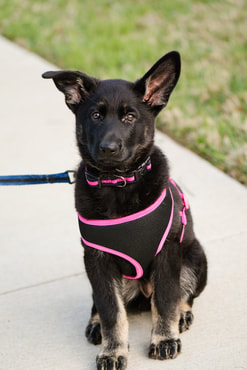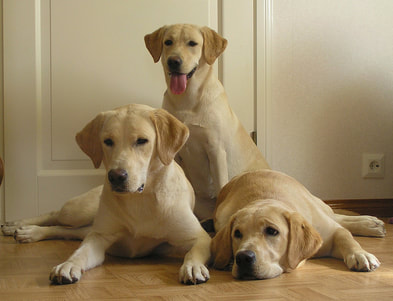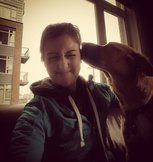
The most important part to analyze first is that dogs, much like humans, must still be conditioned to their levels of activity. Owners will vary from an extremely active lifestyle, to a significantly more sedentary one; it is important to initially choose the right breed to match that way of life, and remember it takes time for their muscles to adapt to new levels of exercise.
I have presented some common breeds of varying athletic levels; however, I will preface that, new or old, all pet owners do their due diligence to ensure their pets healthiest life.
GERMAN SHEPHERD
The German Shepherd dog is among the top ten most popular dog breeds in the United States, and is globally recognized. This dog breed is not for the frequent traveler. They are an active and intelligent breed that must be kept working.
Daily exercise, from mental training, to a physical job - jogging, catch and training exercises - is necessary for a healthy lifestyle. Without the proper exercise, a German Shepherd will tend to become anxious, destructive and much more difficult to train properly.
DAILY EXERCISE MINIMUM: (Extremely Active - High Energy) 1 Hour per day - including one walk, and one high intensity activity.

Labrador’s are an extremely active breed that can face some severe consequences from lack of exercise. They are prone to obesity and becoming extremely bored if not actively worked. This pent-up energy will inevitably lead to destructive behavior, much like the German Shepherd.
It is also important to not the activity differences between a Working (American) Labrador and the Show (English) Labrador.
The Working lab tends to be easier to train, and have a significantly higher endurance with age. On the other hand, the Show lab tends to have very high energy, playfulness, and 'distractibility' at a younger age - will approach other humans and dogs freely.
The Working breed is a perfect companion for the frequent hiker, the cuddler (they work well with constant physical attention) and anyone looking into a dog/owner sport.
The Show lab is a great choice for those who want to bring their dog along to the beach to run freely, for slow walks, and for less outdoor ‘intensity’ - The English Retriever is much less prone to a prey drive.
WORKING (AMERICAN) LAB MINIMUM: (Extremely Active - High Learning Ability) 1 hour per day - Training exercises are extremely important, as well as a multitude of high intensity exercises.
Exercise Suggestions: Command training is a must. Jogs, fetch, and nose work are perfect forms of stimulation.
SHOW (ENGLISH) LAB MINIMUM: (Very Active - Energetic, Playful, Roamer) 45 minutes per day - a walk and higher intensity free play are important. English labs can be great companions for younger kids, and other animals in the household.
Exercise Suggestions: Hikes, free roam on beaches, playtime at home, and command work with treats.

The Pembroke Welsh Corgi, are our favorite furry-butt potatoes. They can often be mistaken for less-active, apartment style dogs; however, you could be quite surprised by their high endurance, and propensity to run (everywhere).
The corgi can be an extreme troublemaker, regardless of activity level. But, they are smart, quick learners, with an aptitude for physical puzzle challenges (such as mazes). Corgis thrive on being the center of attention, and their activity type should reflect this.
If you are the owner, or plan to be, of a corgi, prepare to put a lot of focus on your new family member. Training these little guys early can help with their stubbornness as they age.
Though active and endurable, our stubby-legged friends do not need to run miles like the retriever or shepherd. They do not need a house to be content, but if you are confined to a smaller space without a yard, I suggest multiple shorter walks a day (brisk pace preferred), and a lot of mental stimulation games.
DAILY EXERCISE MINIMUM: (Active - Playful/Stubborn - Strong Willed) A few short, stimulating walks a day. Three 15-minute walks should do. As well, as some mental training in, or out of the house.
Exercise Suggestions: A one mile jog, running at a park/beach, high-intensity playtime, mazes or nose work.

The pug is our notoriously lazy friend. Shaped like a cannonball of cuddles, their looks are a direct representation of their activity level. Perfect for the apartment or small home without a yard, or an owner who cannot provide a lot of physical attention.
Too high-intensity exercise can lead to joint problems, so with these little guys, stick to some gentle playtime.
A quick warning about pugs, they can, and will overheat quickly. They do not need a great deal of exercise, but a couple brisk walks a day should do the trick. Plus, access to a park or a free play area would not hurt - unlike some other active breeds, pugs may quit out on the running fairly quick.
DAILY EXERCISE MINIMUM: (Low Activity - Be cautious of harsh outdoor temperatures) Two 20-minute walks a day.
Exercise Suggestions: Some free-play outside, or fetch indoors should get them moving. Any pug willing to play with toys, should be allowed to interact with you as much as they deem fit - unless excessive. They will often quit out quickly.
Jogs, Runs Fetch, Agility Sets (Home made or purchased), Hikes. For mental work: Puzzle toys, tough chew toys with hidden treats, routine training and command work.
I have provided some fairly broad recommendations, even for these specific breeds. As the good owner I know you are, make sure to do some extra research before adopting




 RSS Feed
RSS Feed

